Huawei Mate 8 Review

Update: You can now read our Huawei Mate 9 review!
Introduction
Surging to new heights after the successful release of the Google Nexus 6P, consumers around the world are becoming increasingly aware of the company behind the prized phone. Huawei’s remarkable run in 2015 is extending already into the New Year, where it used CES 2016 to announce its latest smartphone in the Mate lineup – the Huawei Mate 8.
It’s been over a year since its predecessor launched, but even more pressing is that the bar has since been raised by the Nexus 6P, so the Mate 8 is predisposed to a higher level of expectation. Similar to the recent Mate S, however, we’re a bit skeptical about its worth being attached with a starting price of €599 (~$650). That’s quite a wallop considering all things, but let’s find out how it fairs.
The package contains:
- Huawei Mate 8
- 2A Wall Charger
- microUSB cable
- SIM ejector tool
- Earphones
- Protective case
- User guide
Design
Huawei produces a great all-metal phone design.
By now, there’s no denying it. Huawei is able to play on the same level with established industry brands such as HTC, when it comes to delivering quality all-metal designs. The Mate 8 is a beautifully crafted, all-metal design with a subtle curve that employs many of the design characteristics we’re familiar seeing in the Mate series. And for something adorned with a 6-inch screen, it doesn’t feel oversized at all, as they’ve kept it pretty svelte and lightweight. By no means is it meant to be a one-hand device, but the aesthetics make it a far more forgiving thing to handle.
Many things about the phone’s design have been meticulously thought out, like the arrangement of its SIM slot, which fashions together the microSD, nanoSIM, and microSIM slots into a singular unit. If that’s not versatility, then we don’t know what is. There’s also the recessed fingerprint sensor on its back too, which, just like the one in the Nexus 6P, is remarkably accurate and responsive – plus, it’s in a good placement as we hold the phone.
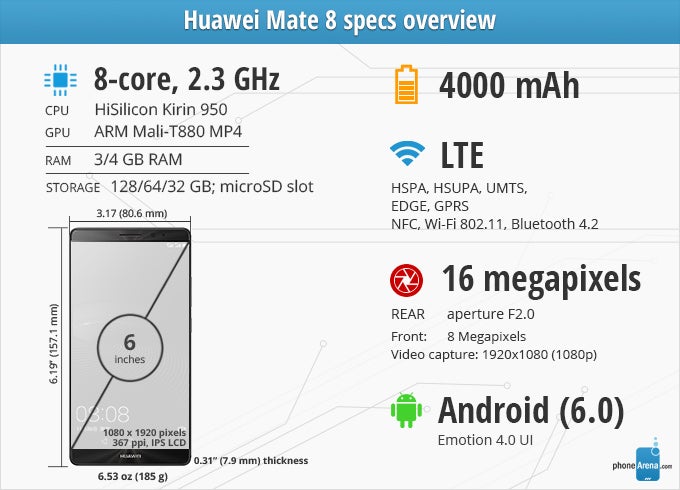
Display
Same overblown colors as usual, but it comes with a more potent luminance.
The Mate 8 comes with a 6-inch IPS LCD display that's slapped with 1080p resolution. The resulting pixel density of 367 ppi is certainly sufficient in reading out fine text with our eyes from a normal distance.
Thankfully, the display that’s present here is significantly more improved with its brightness output than the one in the Mate S that we reviewed last month. In particular, its peak luminance reaches 492 nits, making it more visible under direct sunlight. However, it shares the same color reproduction as the Mate S, as opposed to the more accurate panel of the Ascend Mate 7 before it. Therefore, colors appear overblown, which some folks won’t mind, but the results aren’t necessarily true-to-life.
Interface and Functionality
EMUI 4.0 goes back to that ‘more is better’ strategy, but it can come off disorganized.
Rather than rehashing in detail again, we’ll just cut to the point and say that the Mate 8 is running the newer EMUI 4.0 skin on top of Android 6.0 Marshmallow. Having the latest build of Android is great news for fanatics, but the underlying custom skin still prides itself in being one of the most feature-filled experiences out there. That’s a good or bad thing depending on who you talk to, however, even with Huawei’s best efforts, we’re inclined to say that it’s still a smidgen behind Samsung and LG’s interpretations.
Visually, the interface is skinned in all the appropriate areas, like the dialer and calendar. Functionally, it bears a wealth of features that adhere to power users, such as its one-handed mode, side-by-side multi-tasking, and gesture (knuckle) controls, but they’re not as refined as we’d like. For example, the side-by-side multi-tasking is limited to only a handful of native apps – far from the more diversified support we find in TouchWiz.
While the core functions of Android are present, EMUI 4.0 attempts to be the mega Android experience with its set of exorbitant features, but the end result lacks cohesiveness and a clear direction.
System Performance
The Kirin 950 is a benchmark trailblazer.
If this is any indication of what’s on the horizon, then Huawei is shaping up to be a formidable force because its home-brewed 64-bit Kirin 950 SoC delivers impressive results with the Mate 8. Our particular review sample features 3GB of RAM, but there’s another model with 4GB. Either way, the benchmark scores are off the roof!
In reality, the processing power propels every action to be accompanied with a pleasant level of responsiveness, but we wouldn’t say it’s as tight as the Nexus 6P’s performance with stock Android. Still, it continues to impress with its better-than-average graphics processing performance.
Accompanied with 32GB of internal storage, while the other variant comes with 64GB, we can all sleep knowing it’s not going to be an issue because there’s room for expansion courtesy of its microSD slot.
Camera
You’ll relish over its vast shooting modes and controls, but the quality of the camera leaves more to be desired.
In complementing the rich camera gear, the Huawei Mate 8 runs the same diversified camera interface we’ve seen in many iterations of its EMUI skin. There’s a vast set of tools, shooting modes, and yes, a manual mode as well to please advanced users, but despite all of its prowess in the still shot department, the video recording experience is still largely an automatic affair once the record button is pressed. Indeed, there are manual controls to preset parameters like the focus, but once it starts recording, they can’t be adjusted on the fly.
Image Quality
The hardware sounds delightful on paper, but in reality, we find its performance to be at best average. Scenes with abundant lighting are handled nicely by the camera, churning out sufficient details and mostly neutral colors. Going indoors, however, artificial lighting tends to cast a noticeably greenish hue to our shots – while details become significantly softer. And even though noise is kept to a minimum under low light, the lack of detail in the shots simply makes everything subdued. Plus, its auto-focus becomes erratic at times as well.
Video Quality
You’d think a phone of this caliber would be endowed with 4K UHD recording, but that’s not the case. Overall, its 1080p samples fail to impress with its soft-toned looks – there’s just no meaningful presence of fine detail. However, its auto-focus is snappy and the audio recording is mostly clear. Going with the standard 30FPS mode, there’s an option for its stabilizer feature, but the camera is very prone to this wobbly, jello-like effect when moving around.
Multimedia
We can’t complain about its on-the-go media consumption.
If you can stomach the color inaccuracies of the display (or at least partially correct for them by setting white balance better), you'll find that the 6-incher of the Mate 8 is a good fit for on-the-go media consumption. Like most high-quality phablets, really.
The video and music players are both pretty basic and offer little more than you'd expect from a built-in solution. The Gallery is a bit different in that its photo editor is actually quite powerful and integrates features — such as pixelization for censoring parts of the image and a bucket load of filters — that you'd usually be forced to seek elsewhere.
Unfortunately, the internal speaker is underpowered, mustering up a maximum output of 71.4 dB. While that’s sufficient for smaller spaces and produces a neutral audio tone, it just doesn’t have the substance to make it sound commanding. Conversely, using the headphone jack with DTS enabled delivers an enjoyable experience that’s rich sounding.
Call Quality
Not bad, thanks to ‘loud voice mode.’

Battery
Great battery life that won’t disappoint.
You wouldn’t believe it by looking at its slim profile, but Huawei is somehow able to stuff a 4000 mAh battery into the Mate 8’s body. However, since the device's settings didn't allow us to set its display brightness at anything close enough to 200 nits, we were unable to run our custom battery test (which we're always running at 200 nit display brightness).
Despite that, we’re satisfied by its real-world battery life performance – where it easily eclipses a full day. By the end of the night, we find the handset generally around the 40% to 50% range, which is impressive in our books. And while its 156 minutes of charge time isn’t the fastest in comparison to the greats, we have to bear in mind that it’s packing a significantly larger battery than many of its contemporaries.
Conclusion
The handset is already available overseas, where it’s slapped with a starting cost of €599 ($643). That’s honestly tough to swallow, given that we can spout out several phones that have better characteristics and performances – plus, several of them are lower in price. That said, it’s still not a crazy idea to import it, if you truly want a phone that looks different from everything else sold here domestically.
Software version of the review unit:
Android Version: 6.0
Build Number: NXT-L29C900B116
Kernel Version: 3.10.86-g47269b5

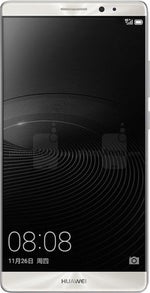

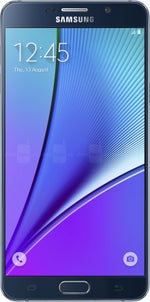























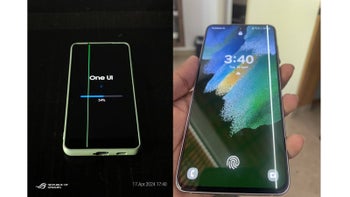
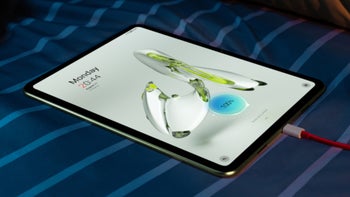
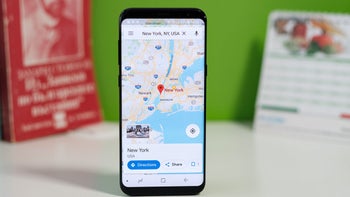
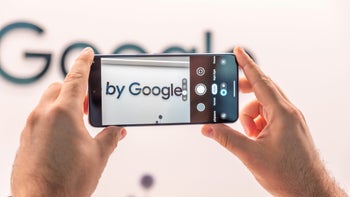
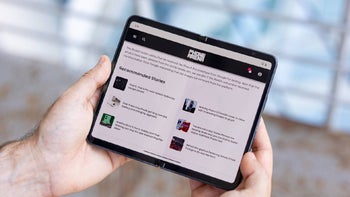
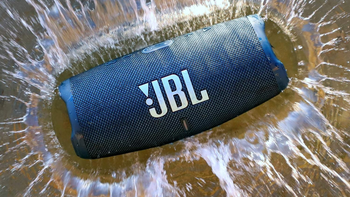
Things that are NOT allowed: